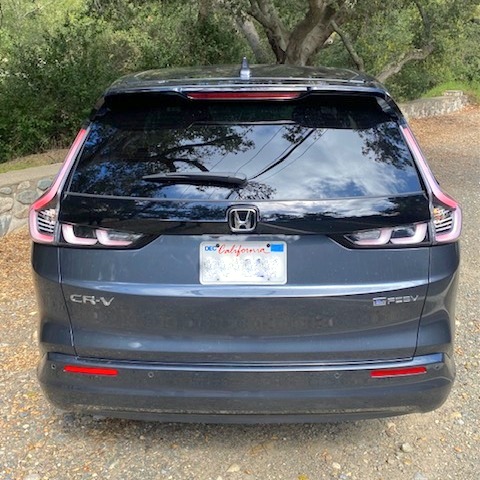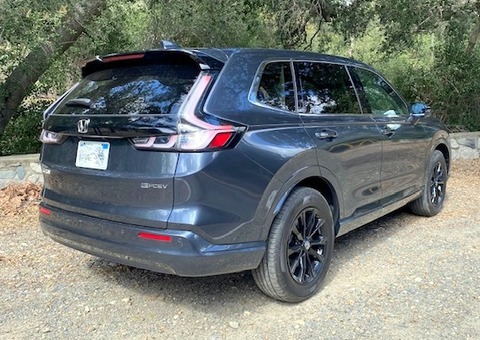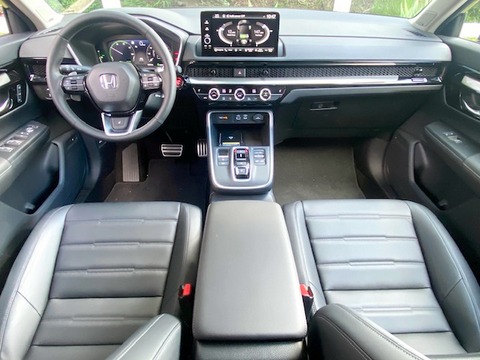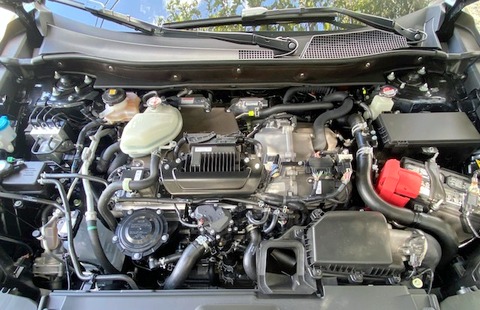The First Plug-in Battery Hydrogen Fuel Cell Electric Goes on Sale
This week Honda announced pricing for the CR-V e:FCEV, which is scheduled to go on sale in California (only) next month. In a first-ever technology pairing, Honda has mated plug-in battery electric and hydrogen fuel cell electric in the all-new 2025 CR-V e:FCEV. This breaks the norm of a fuel cell vehicle run solely on hydrogen. The e:FCEV advances the company’s zero emissions goals–100-percent of its vehicles will be battery electric or fuel cell electric models by 2040, and the company will reach carbon neutrality by 2050. Clean Fleet Report got a chance to give the model a short test drive recently ahead of the public launch.
Getting To Know the CR-V e:FCEV
2025 CR-V e:FCEV, plug-in hydrogen fuel cell electric vehicle, is essentially a CR-V Hybrid with the addition of plug-in charging and with hydrogen replacing gasoline. With a 270-mile all-electric driving range (AER) from the 92.2 kW electric motor fed with electricity created by the fuel cell, and up to 29 miles of range coming from the 17.7 kWh battery, this combination offers some interesting possibilities for California drivers.

A chemical process employing oxygen and compressed hydrogen takes place in the fuel cell, creating electricity to power the motor and charge the lithium-ion battery. The by-product is water vapor that harmlessly drips from the tailpipe, making the e:FCEV a zero-emission vehicle. The fuel cell stack is a joint project between Honda and General Motors.
The e:FCEV’s plug-in battery charges in less than two hours with a Level 2 240V EV charger, or about 10 hours using a common 120V household plug. Level 3, DC Fast Charging is not available. Charging nightly and driving under 29 miles will mean less need for hydrogen fuel, which is currently available at one of about 50 stations in California.
Fuel economy is measured as MPGe (miles per gallon equivalent). The CR-V is rated at 61 MPGe city/52 highway/57 combined using a combination of the electric battery and compressed hydrogen fuel. MPGe is a measurement of how far a car can travel electrically, on the same amount of energy as is contained in one gallon of gasoline.
The closest comparisons for hydrogen-only cars are the Toyota Mirai and Hyundai Nexo, but there are no direct competitors using this unique combination technology.

Pricing
Available in one trim level and for lease only, the 2025 CR-V e:FCEV is priced at $50,000 (about $10,000 more than the top trim level gas CR-V Hybrid), which includes the mandatory $1,350 delivery and handling fee. It will qualify for federal and California tax credits, as well as the coveted HOV sticker that allows for a single driver to use the carpool lane. See your tax advisor before visiting your local Honda dealer. Three lease plans will be offered:
- $489/month for two years
- $459/month for three years
- $389/month for six years
- All plans have $2,959 due at signing, allow for 12,000 miles per year (except the two-year term that allows 60,000 miles) and provide $15,000 per year in credit for hydrogen fueling (the two-year term has a $25,000 credit).
Drives Likes a Crossover (Because it is a crossover!)
Our time behind the wheel was on city streets and parkways, spiced-up a bit with some twisties to attack. Honda is not marketing the e:FCEV as a sport compact crossover, but it held its own nicely as we carved a two-lane country road, following alongside a river that was lined with California oak trees. The front-wheel drive e:FCEV with 235/60 all-season tires on 18-inch wheels, has a MacPherson strut front and multilink rear suspension that has been re-tuned for the e:FCEV. Additional suspension tweaks include specific springs, amplitude-sensitive dampers and stabilizer bars front and rear to optimize responsiveness.
The e:FCEV drives likes a very competent, gasoline or gasoline-electric hybrid crossover, with its electric drivetrain only making it smoother and quieter.
The e:FCEV’s performance from the 174 horsepower electric motor with 229 pound-feet of torque produces an 8.5 second 0-60 mph time. While not fast by EV standards, it will get the job done for entering freeways, which is what the e:FCEV will be doing a lot of as it will only be leased in California when it hits dealers in July.

The drive modes are Normal, Econ, Sport and Snow, with Normal and Sport our favorites for accelerator feel and performance. Extended 65+ mph cruising is when Econ would be considered, but know the accelerator pedal is dumbed-down a bit and the A/C doesn’t run at full pop, both of which are compromises for getting more range.
The e:FCEV is not available with all-wheel drive, but with few hydrogen fueling stations in the Sierra Nevadas, the Snow mode probably will not be called on too often.
Having previously driven a 2024 CR-V Hybrid, the 500-pound weight difference between the two was noticeable, but not in a bad way as the extra heft gave a solid feel to the ride, adding to stable handling. Braking on the e:FCEV was a bit longer than the hybrid, but once understood, adjusting for it was not an issue.
The CR-V e:FCEV has regenerative braking that is set by pulling the left steering wheel paddle four times to increase, four times on the right paddle to decrease. Even in the fullest setting the regenerative braking force is not very strong compared to most EVs we have driven.
It is not a full one-pedal driving system as it automatically shuts off when slowing to seven miles per hour. At this point, apply the brake pedal to stop, set the Brake Hold button, and the e:FCEV will stay in place until you press the accelerator. Both the regenerative level not being strong and not having true one-pedal driving were curious. However, as we were reminded by the Honda team, the CR-V e:FCEV we drove in March 2024 was a prototype, and with the on-sale a few months away, things may change on the production model.
Contemporary Design/Comfortable Interior
Design-wise, the CR-V e:FCEV and the CR-V Hybrid are similar. Subtle-but-obvious differences are the e:FCEV is three inches longer, the front end is sleeker with a smaller upper grille and it has different lower front and rear fascia, narrow headlights that lead to a longer hood, new vertical tail lights and 18-inch, 10-spoke black wheels.

The CR-V Hybrid e:FCEV comes in one trim level of Touring. The driver and passenger seats are heated, with power adjustments. The cockpit design is similar to the CR-V Hybrid, with a 10.2-inch digital vehicle information screen, and a 9.0-inch HD touchscreen for the 12-speaker Bose audio system with Apple CarPlay and Android Auto.
Overall, the build quality was at a high level. The honeycomb pattern dash panel, soft surfaces on the dash and door panels, wireless phone charging, heated steering wheel and dual zone climate control made for a welcoming cabin. The shift-by-wire gear selector, located in the center console, opens space compared to a conventional shift lever.
The reclining (nice touch, Honda!) rear seats are made for grown humans: two comfortably but three for short jaunts. The rear seat, divided by the fold down armrest with cup holders, had ample leg and shoulder room. With no sunroof option, the head room was excellent. While the rear seat folds 60:40 for storage, the space is compromised a bit as the 4.3 kilogram fuel tanks were placed under the rear seat. However, the recessed storage area in the far rear of the cargo area has a cover to provide wandering eyes from spotting tucked away valuables.
Safety
All CR-V (gasoline, hybrid and e:FCEV) models come standard with active and passive safety features such as front and side air bags. Honda Sensing, Honda’s advanced driver assistance systems (ADAS), includes forward collision and road departure mitigation, lane keep assist, and adaptive cruise control.
Warranty

- Basic – Three years/36,000 miles
- Plug-in and Hydrogen Systems – Eight years/100,000 miles
- Maintenance – One year/Unlimited miles
- Roadside Assistance – Three years/Unlimited miles
Availability
The 2025 CR-V Hybrid e:FCEV will be available at these 12 California Honda dealers.
Northern California
- Dublin
- Oakland
- Palo Alto
- Roseville
- Serramonte (Colma)
- Stevens Creek (San Jose)
Southern California
- Cerritos
- Culver City
- Irvine
- Pasadena
- Torrance
- Woodland Hills
Hydrogen Considerations
- Hydrogen costs (as of June 2024) $33 per kilogram (kg), so the e:FCEV’s 4.3 kg tank will cost about $142 to fill (of course, Honda covers that cost as part of the lease). It takes about five minutes to fill the tank.

- Hydrogen fuel stations, just like electric charging stations, have a spotty record of not being operational at all times. This is why it is crucial to use an availability website, such as the one from the Hydrogen Fuel Cell Partnership.
- Hydrogen prices fluctuate in a broader range than gasoline or electricity. In 2022, it was $16 per kilogram compared to now where it sits around.
- Versus an electric car, the cost to fueling difference is substantial. The cost to charge an electric car with a 66 kWh battery and 300 miles of range (comparable to the 270 AER of the CR-V e:FCEV), with a California average of 19.39¢ per kilowatt hour for electricity, would cost about $12,. With a home charger and solar panels, the cost to charge an EV would be even less.
- The e:FCEV is not a car to be driven outside California since there is no national hydrogen fueling network.
The State and Future of Hydrogen
There are about 50 operating hydrogen fuel stations in California, and the availability of hydrogen is sometimes spotty. For perspective, China, which is far larger than California, has 250 and Japan, which is roughly the same size as California but populated by three times as many people, has 160 stations.
The state has recognized hydrogen-powered cars as part of its drive to zero-out tailpipe emissions (and the resulting dangerous smog) for three decades and helped support the development of vehicles and infrastructure. The hydrogen fueling station network is slowly being built out, funded in part with state support that averaged $20 million/year for the past couple decades.

In October 2023 Gov. Newsom signed a funding bill to invest $106 million in the construction of additional hydrogen stations through the end of the decade, for the first time backing stations for commercial vehicles as well as passenger cars. The need for more stations is necessary if this fuel is to ever gain consumer acceptance for their everyday vehicles.
Honda is betting (and investing big) in hydrogen fuel. In addition to the 2025 CR-V e:FCEV for consumers, Honda Motor Company and Isuzu Motors Limited are branching into commercial vehicles. The Giga Fuel Cell, a zero-emissions FCEV heavy-duty truck with an estimated 500-mile range, was shown for the first time at the Japan Mobility Show 2023. Projections are to introduce a production model in the Japan market in 2027.
Honda showcased a proof-of-concept Class 8 hydrogen fuel cell truck at the ACT Expo in May 2024, and is in talks with potential customers. Honda also hopes to apply its fuel cell system to construction equipment, such as excavators and wheel loaders, to help leading the construction industry to carbon neutrality.
Honda is following its rival, Toyota, which with Kenworth debuted a co-developed a Class 8 FCEV truck, code named Ocean, with a zero-emission 300-mile range, in 2022. Peterbilt also worked with Toyota and offers its Model 579HFC for sale. Volvo Group and Daimler Trucks also have a joint venture to develop fuel cell technology.
Observations: 2025 Honda CR-V e:FCEV
The Honda CR-V compact crossover utility vehicle (CUV) has been one of the most popular CUVs in America and accounts for more than 56 percent of Honda’s CUV/SUV sales and a third of all the brand’s sales. Updates since its debut in 1997 included the first CR-V Hybrid in 2020.

Next, the all-new 2025 CR-V e:FCEV will be released in July 2024. Jay Joseph, VP sustainability, confirmed this is continuing Honda’s “long-term investment and 40 years of experience” in electrification, and its quest to “make hydrogen more accessible” to the public.
Keep in mind the 2025 Honda CR-V e:FCEV will only be leased in California, and only 300 are committed to being built annually. Compared to its FCEV competitors (also only sold or leased in California), the Toyota Mirai (357 to 402 AER) and Hyundai Nexo (354 AER) it has a lower overall driving range. But these models don’t have a plug.
The key to making the 2025 Honda CR-V e:FCEV work (and its ace in the hole) for your budget and convenience, will be home charging and using the 29 all-electric mile driving range to its fullest whenever possible. If most of your driving is close to home, and you are tempted to take the hydrogen plunge, then the Honda CR-V e:FCEV may be a better hydrogen fuel cell electric vehicle option.
Honda’s test of the e:FCEV for how a plug-in hydrogen fuel cell vehicle operates in the real world will reveal its acceptance by the public. And they couldn’t have done it in a better place since Californian’s are EV-savvy and EV-crazy (and have cumulatively purchased more than 15,000 fuel cell vehicles).
It will be built by-hand in Marysville, Ohio at Honda’s Performance Manufacturing Center, the same facility that hand-built the very sporty Acura NSX.
Make sure to opt-in to the Clean Fleet Report newsletter (top right of page) to be notified of all new stories and vehicle reviews.
Story and photos by John Faulkner

1 thought on “Flash Drive: 2025 Honda CR-V e:FCEV”